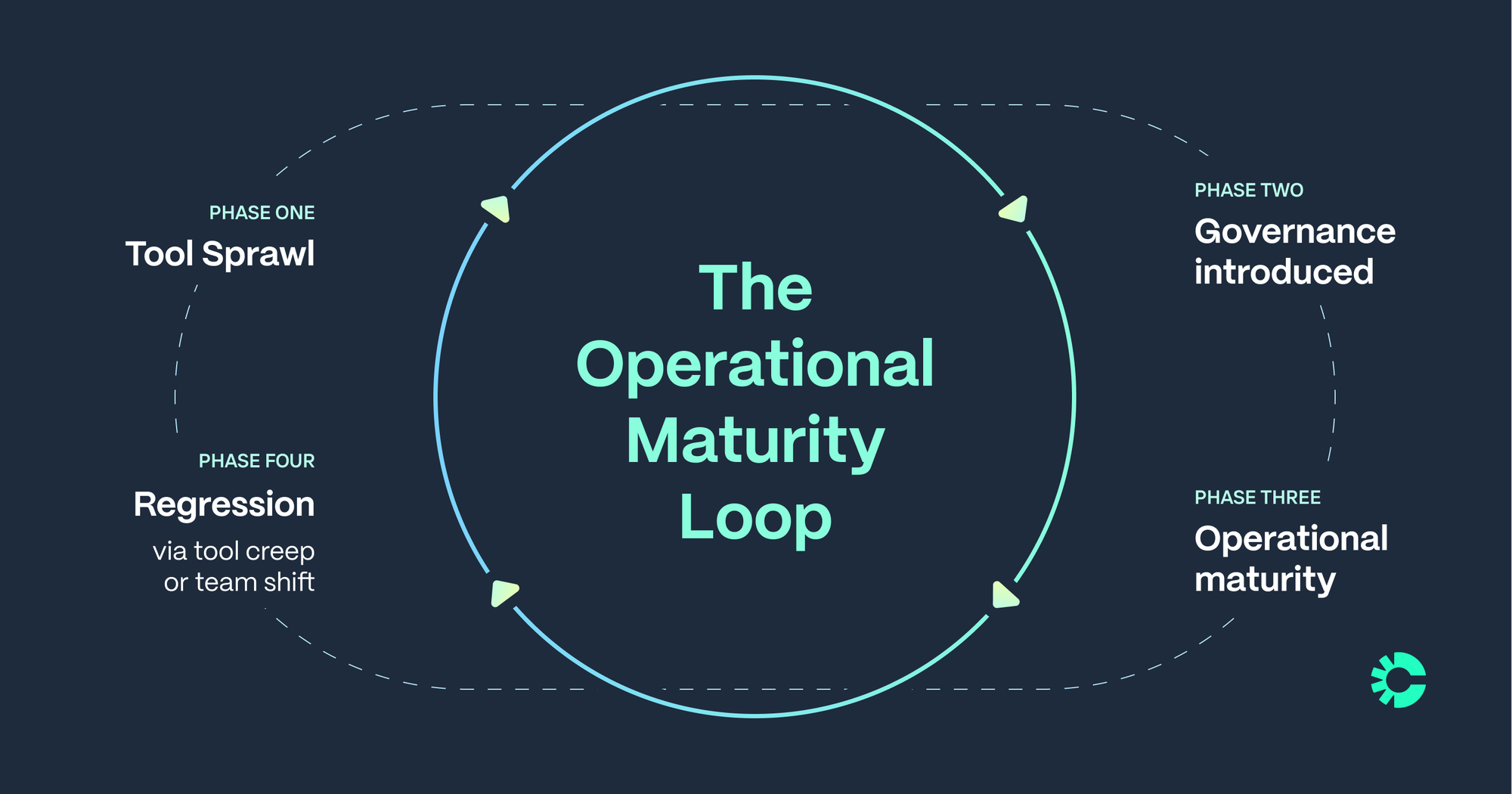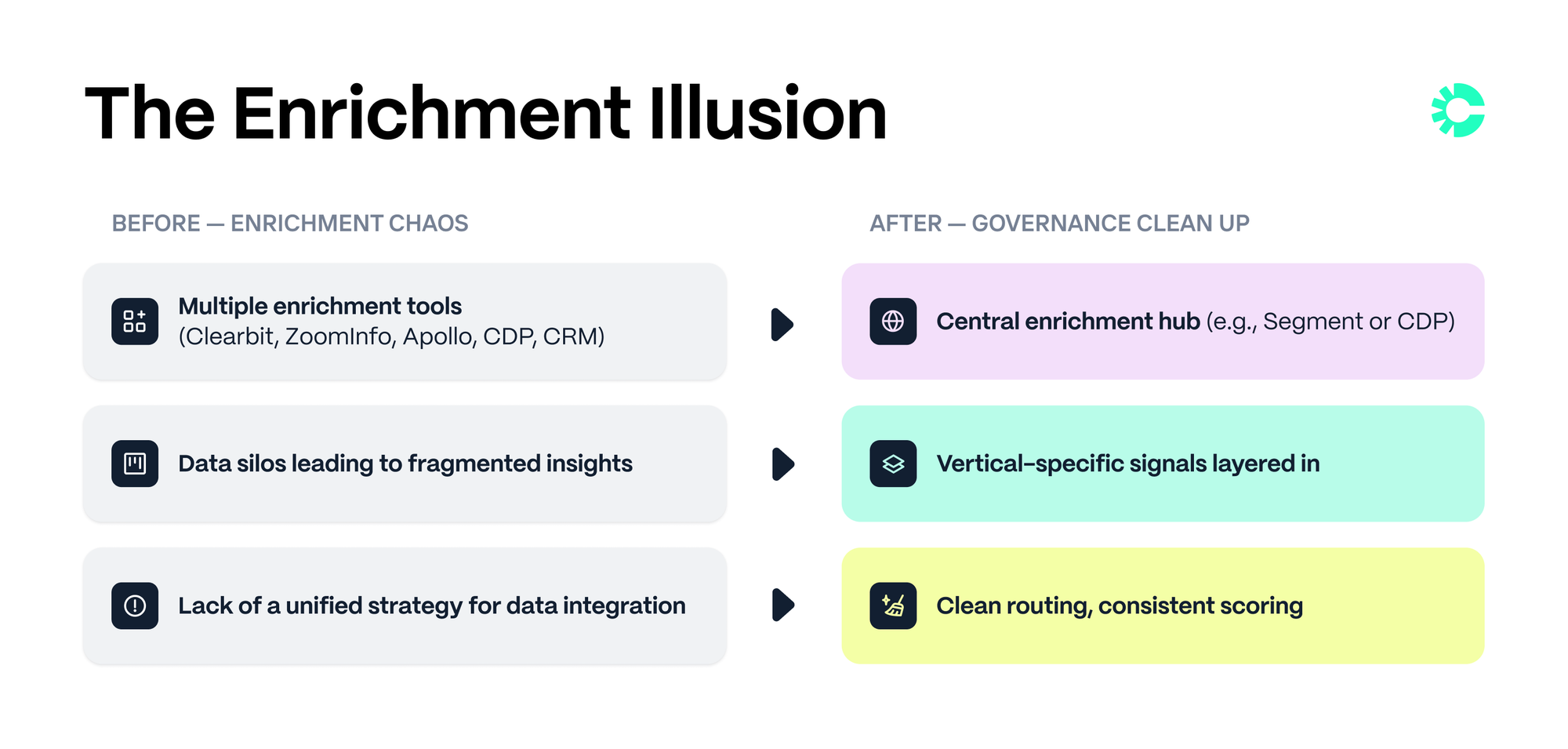The RevTech maturity loop (and how to stay in it)

Most companies think the answer to RevTech complexity is smarter tools.
But the companies actually scaling cleanly in 2025? They’re not chasing features. They’re building systems — systems that reduce duplicative enrichment, keep marketing, sales, and ops aligned, and let small teams punch way above their weight.
Just ask Kiki Burton, Chief Growth Officer at Upside. She’s led RevOps transformations at scale and has seen firsthand how stack sprawl, redundant tooling, and poor enrichment logic slow teams down. Her lens brings sharp, practitioner-backed clarity to the messy realities of growth.
The secret isn’t better automation. It’s better governance. And thanks to AI, governance has never been easier.

When maturity creates mayhem
When I was at Ramp, we had all the right tools. Sophisticated enrichment logic. Smart scoring systems. Routing rules that looked bulletproof on paper. A setup any RevOps consultant would admire.
But tools alone don’t guarantee coherence. Somewhere between the customer relationship management (CRM) system and the customer data platform (CDP), things broke. And they broke quietly.
Leads were being enriched multiple times — sometimes six times in a single day. Not intentionally. Not maliciously. Just automatically. Because no one owned the process. Each platform — Clearbit, HubSpot, Salesforce, Looker, Segment — had its own version of the truth.
The result? Total fragmentation. Marketing activated audiences across five systems, each built from different data. Reporting became an exercise in fiction. Attribution suffered. Follow-ups went misaligned. Instead of enabling speed, our RevTech stack had become a source of drag.
This wasn’t over-engineering. It was under-governance. Our systems weren’t broken because of the tools we picked — they were broken because no one owned how those tools were used.
Governance begins before you buy
Too often, stack decisions begin with spreadsheets — rows of tools, columns of features, demos booked and evaluated.
But no one stops to ask: How will this change our workflow? Who will own it? How will we know if it's working?
At Clarify, we forced ourselves to answer those questions before signing a contract. It wasn’t glamorous. But it gave us leverage.
Every new tool had to clear three checkpoints:
- What problem are we solving?
- Can we solve it using what we already have?
- Who owns the outcome end-to-end?
This wasn’t about being anti-tools. It was about building the muscle memory to choose well and integrate intentionally. Tools weren’t decisions — they were dependencies. And like any dependency, they came with a maintenance burden. Better to pause before reaching for the shiny new thing.
The new cost of doing nothing
Governance used to be an operations tax: something teams acknowledged, but deprioritized until something broke.
This reality has flipped. AI has quietly shifted the cost-benefit equation. We used to need a full-time RevOps hire for this kind of governance work — now we can tackle it in an afternoon with the right transcript, the right prompt, and the right framing.
Here's what that looks like in practice:
- Record a 30-minute working session.
- Feed the transcript into Claude or ChatGPT.
- Ask: What tools were mentioned? Who owns what? What’s being duplicated?
- Get a visual map or clean standard operating procedures (SOPs) in return — faster than you could schedule your next sync.
This isn't a hypothetical. It's how we're operating at Clarify today.
Each week, we document changes to our stack in real time. We log ownership. We review friction. We track the ripple effects of each new integration or vendor. And we do it using AI to remove the administrative burden.
This isn’t flashy work. But it’s fundamental. It saves hours of troubleshooting later. It makes onboarding faster. It reduces vendor bloat. It gives marketing ops and sales leadership a shared source of truth.
And, most of all, it gives us confidence. Confidence that the system we've built is something we actually understand, not something we’re constantly untangling.
We’re not failing because governance is hard. We’re failing because we still think it is.
Why you should never build your own ESP
This isn’t just a cautionary tale — it’s a warning label.
At Credit Karma, the team built their own email service provider (ESP) — and ironically named it Kiki. Cute name, painful outcome.
It required 30 engineers to maintain. Not to improve. Just to keep it running.
One former team member said the system “caused a lot of pain and frustration.”
Even Walmart tried to build their own ESP. They gave up and switched to Braze.
Lesson: Don’t rebuild the bones. Buy them. Build around them.
At Ramp, we applied this lesson directly. We leaned on proven infrastructure — Segment, HubSpot, Snowflake — and spent our time refining the connective tissue. We wrote custom enrichment logic, triggered workflows via API, and maintained clean data lineage throughout.
The leverage wasn’t in any one tool. It was in how they worked together.
“Just one more tool” is a dangerous idea
No one plans for sprawl. It sneaks in through urgency.
A new data need. A campaign deadline. A feature gap. It’s always easier to buy something than to understand what you already have.
Before we introduced any governance, Ramp had more than 100 admin users across the go-to-market stack. Most of them were inactive — ghosts with full access.
So we created a gating function: a Slack channel called #go-to-market-stack-help. If you wanted a new tool, you made your case. If you had a question, you asked it there.
Most of the time, the answer was, “We already have something for that.”
This wasn’t about creating friction. It was about redirecting it away from retroactive cleanup and into intentional decisions. The result wasn’t just fewer tools — it was a tighter process. New requests slowed. Duplicates got flagged. Admin access got cleaned up. The stack got lighter and faster to navigate.
The enrichment illusion

Enrichment is where most stacks go to die.
Every vendor promises better coverage, fresher data, more signals. So you buy Clearbit. Then ZoomInfo. Then Apollo. Then something niche.
What no one tells you: Many of them are reselling the same data from People Data Labs (PDL).
At Ramp, we ran a test. PDL vs. a hyped enrichment startup. 100% match. The difference? UI and cost.
Meanwhile, our leads were getting enriched in several different systems. Same contact. Different scores. Different costs.
At one point, we were only bringing in 3,000 to 5,000 leads a day — nowhere near the volume that would justify an unlimited enrichment plan. But because each of those leads was getting enriched six different times across disconnected systems, we couldn’t even keep track of how many credits we were burning. It was chaos masquerading as sophistication.
Kiki took a smarter approach at Upside:
- Use general providers for baseline signals.
- Layer in vertical-specific sources (like Brizo for franchises).
- Centralize enrichment to one system, not five.
This isn’t about cutting tools — it’s about cutting noise. Specialized data beats redundant data every time.
Why pipeline, not MQLs, should be the north star
Marketing qualified leads (MQLs) made sense when systems were siloed.
Marketing had one job: create interest. Sales had another: convert it.
But the line between these motions is gone.
At Upside, marketing runs outbound. Sales development representatives (SDRs) sit on the same team. And everything rolls into the same profit and loss (P&L) statement. Kiki doesn’t care who sourced it — she cares if it closed.
“If we’re going to spend $20,000 on a lead, that account executive (AE) better be following up the second someone fills out a contact sales form.”
At Clarify, same deal. Chris runs outbound campaigns, but he’s a marketer by title. Everyone owns pipeline.
No more channel debates. No more attribution battles. Just “did it move revenue?”
It’s not just a structural change. It’s a cultural one. And it changes how you build your stack. When everyone is responsible for revenue, tools get chosen differently. Metrics get tighter. Meetings get more productive. This alignment turns into execution.
RevTech maturity is a loop, not a ladder
We love stages. Chaos, sprawl, maturity.
RevTech doesn’t evolve in straight lines. It loops.
You reach maturity, then regress when a team adds a new tool without documentation. You stabilize, then slip when priorities shift.
The point isn’t to achieve perfection, but to build reflexes:
- Weekly reviews
- Change logs
- Ownership docs
- Central help channels
This is how you stay in operational maturity longer — the point where your systems are documented, your tools are aligned, and your team isn’t constantly untangling avoidable messes. And when things inevitably break, it’s how you bounce back faster. At Clarify, these rituals take less than 90 minutes a week and save us exponentially more time downstream.
Before you buy your next tool, ask better questions
Your stack isn’t just software. It’s your operating system (OS) for generating revenue.
And like any OS, it needs structure:
- Clear architecture
- Defined protocols
- Version control
AI has lowered the cost of governance. The remaining barrier? Willingness.
So, before you approve that next vendor, ask:
- What are we solving?
- Are we already solving it somewhere else?
- What systems will this affect?
- Who owns it end-to-end?
The best RevOps teams in 2025 won’t be the ones with the most tools. They’ll be the ones with the most discipline — and the clearest thinking.
Get our newsletter
Subscribe for weekly essays on GTM, RevTech, and Clarify’s latest updates.
Thanks for subscribing! We'll send only our best stuff. Your information will not be shared and you can unsubscribe at any time.
